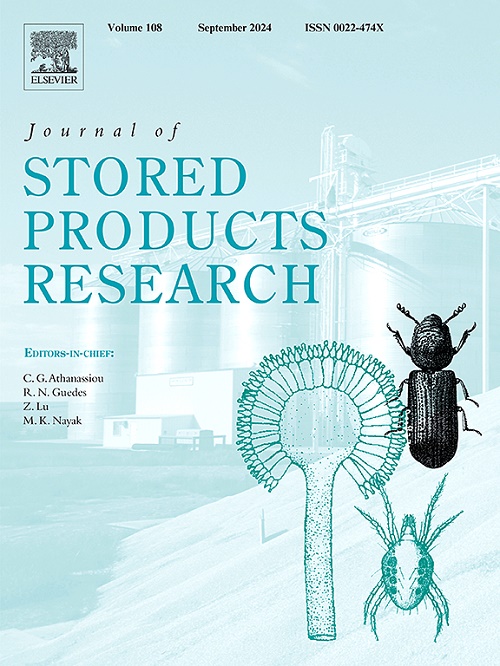三种精选植物精油及其协同组合在治理麦粒上的褐飞虱方面的潜力
IF 2.7
2区 农林科学
Q1 ENTOMOLOGY
引用次数: 0
摘要
Tribolium confusum (Duval) 是贮藏产品中最常见的破坏性害虫之一,对多种杀虫剂具有抗药性。本研究旨在评估来自三种药用植物,即 Satureja calamintha(L.)、Mentha piperita(L.)和 Chenopodium ambrosioides(L.)的精油(EOs)及其组合物对 T. confusum 的杀虫活性。利用气相色谱-质谱法(GC/MS)对环芳烃进行的化学分析显示,水黄皮环芳烃的主要成分是柚木酮(36.8%)、薄荷酮(31%)和薄荷醇(19.8%)。薄荷呋喃(23.73%)和 1,8-蒎烯(20.23%)是 M. piperita 环氧乙烷的主要化合物,而 C. ambrosioides 环氧乙烷的特点是富含蛔虫醚(36.67%)、对伞花烯(34.32%)和异蛔虫醚(22.8%)。通过接触毒性和驱避效果评估了三种环氧乙烷及其复配物对 confusum 的杀虫活性。一般来说,与单个环氧乙烷相比,三元和二元环氧乙烷组合具有良好的毒性,LC50 = 0.022 μL/cm2,LC50 = 0.057-0.078 μL/cm2。考虑到组合指数(CI)和剂量降低指数(DRI)值,所研究的组合物显示出协同和相加效应,并能有效降低剂量。有趣的是,三元组合具有很高的协同效应,CI 值为 0.4。此外,单独和组合的环氧乙烷对测试的害虫都有驱避作用,平均驱避率在 28.8% 到 72% 之间。与游离态(68%)相比,使用浓度为 1000 ppm 的纳米乳化三元环氧乙烷组合在处理过的麦粒中暴露 4 天后,褐飞虱成虫的死亡率最高(100%)。这些发现凸显了三元环氧乙烷组合及其纳米乳液在开发环境友好型杀虫剂方面的潜力,可用于在实际条件下防治褐飞虱。本文章由计算机程序翻译,如有差异,请以英文原文为准。

Potential of three selected plant essential oils and their synergistic combinations in management of Tribolium confusum on wheat grains
Tribolium confusum (Duval) is one of the most common destructive pests of stored products, resistant to a wide range of insecticides. The present study aims to evaluate the insecticidal activities of essential oil (EOs) from three medicinal plants namely, Satureja calamintha (L.), Mentha piperita (L.) and Chenopodium ambrosioides (L.), and their combinations against T. confusum. Chemical analysis of EOs investigated by gas chromatography-mass spectrometry (GC/MS) revealed that the main constituents in S. calamintha EO were pulegone (36.8%), menthone (31%) and menthol (19.8%). Menthofuran (23.73%) and 1,8-cineole (20.23%) were the main compounds of M. piperita EO, while the EO of C. ambrosioides was characterized by the abundance of ascaridole (36.67%), p-cymene (34.32%), and isoascaridole (22.8%). The insecticidal activity of the three EOs and their combinations were evaluated by contact toxicity and repellent efficacy against T. confusum. Generally, ternary and binary combinations showed promising toxicity compared to individual EOs with LC50 = 0.022 μL/cm2 and LC50 = 0.057–0.078 μL/cm2, respectively. Considering the combination index (CI) and dose-reduction index (DRI) values, studied combinations showed synergistic and additive effects with favorable dose reductions. Interestingly, a high synergistic effectiveness was recorded for the ternary combination, with a CI value of 0.4. Moreover, both individual and combined EOs showed repellent effects against tested insect pest with an average repellency rate varying between 28.8% and 72%. The nanoemulsified ternary EO combination used at 1000 ppm, achieved the highest mortality (100%) of T. confusum adults whiting 4-day exposure in treated wheat grains, compared to the free form (68%). The nanoemulsion exerted high efficacy without significantly affecting the wheat germination. these findings highlight the potential of ternary EO combination and its nanoemulsion for developing environmentally-friendly insecticide to be used in the management of T. confusum in real-world conditions.
求助全文
通过发布文献求助,成功后即可免费获取论文全文。
去求助
来源期刊
CiteScore
5.70
自引率
18.50%
发文量
112
审稿时长
45 days
期刊介绍:
The Journal of Stored Products Research provides an international medium for the publication of both reviews and original results from laboratory and field studies on the preservation and safety of stored products, notably food stocks, covering storage-related problems from the producer through the supply chain to the consumer. Stored products are characterised by having relatively low moisture content and include raw and semi-processed foods, animal feedstuffs, and a range of other durable items, including materials such as clothing or museum artefacts.

 求助内容:
求助内容: 应助结果提醒方式:
应助结果提醒方式:


